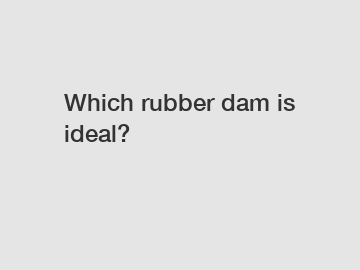Which rubber dam is ideal?
Choosing the Right Rubber Dam for Dental Procedures.
Rubber dams are essential tools in dental procedures that help isolate teeth, protect soft tissues, and provide a clean and dry operating field. With a variety of rubber dams available in the market, it can be challenging to determine which one is ideal for specific dental treatments. In this article, we will discuss the different types of rubber dams and factors to consider when selecting the right one for dental procedures.
Types of Rubber Dams.

There are several types of rubber dams available, each with its advantages and drawbacks. The most common types include:
1. Latex Rubber Dams.
2. Non-Latex Rubber Dams.
3. Heavy Weight Rubber Dams.
4. Medium Weight Rubber Dams.
5. Light Weight Rubber Dams.
Factors to Consider.
When choosing the right rubber dam for a dental procedure, several factors need to be considered to ensure optimal outcomes. Some of the essential factors to take into account include:
1. Allergies: Latex rubber dams may cause allergic reactions in some patients, making non-latex rubber dams a safer alternative for individuals with latex allergies.
2. Thickness: Depending on the specific dental procedure, the thickness of the rubber dam will vary. Heavyweight rubber dams are more durable and tear-resistant, making them suitable for more extended procedures, while lightweight rubber dams are more comfortable and less likely to cause patient discomfort.
3. Size: Rubber dams come in different sizes to accommodate various tooth sizes and shapes. Selecting the right size will ensure proper isolation of the tooth during the procedure.
4. Color: While the color of the rubber dam may seem like a minor factor, it can impact the visibility of the tooth and surrounding tissues during the procedure. Choosing a contrasting color can improve visibility and make the procedure more manageable.
5. Biocompatibility: Rubber dams should be biocompatible to prevent adverse reactions in patients with sensitivities to certain materials. Non-latex rubber dams are an excellent option for patients with allergies or sensitivities.
6. Accessibility: Some rubber dams are designed with perforations to facilitate easy tearing and placement, making them more convenient to use during dental procedures.
Selecting the Ideal Rubber Dam.
To determine the ideal rubber dam for a specific dental procedure, it is essential to consider the unique requirements of the treatment and the patient's needs. By evaluating factors such as allergies, thickness, size, color, biocompatibility, and accessibility, dental professionals can choose the most suitable rubber dam that will enhance the success of the procedure and ensure patient comfort.
Contact Us for More Information.
If you have any questions about choosing the right rubber dam for dental procedures or need assistance selecting the ideal rubber dam for your practice, please do not hesitate to contact us. Our team of dental experts is here to help you find the best rubber dam solutions for your dental practice.
If you are looking for more details, kindly visit containerized wastewater treatment plant, inflatable rubber dam for Thailand, air filling weir for Malaysia.
426
0
0


Comments
All Comments (0)